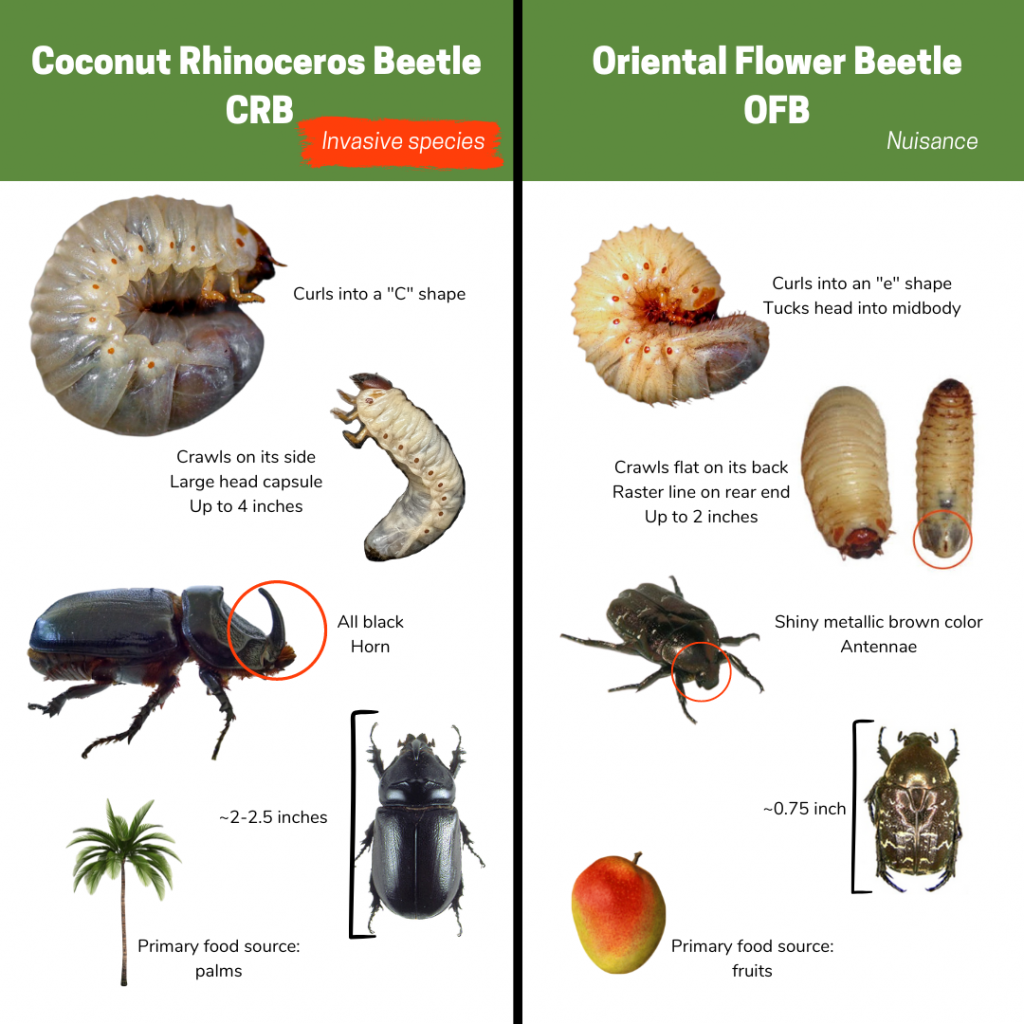
Coconut Rhinoceros Beetle
Oryctes rhinoceros
In Maui County, report any symptoms of feeding damage on coconuts (V-shaped cuts and/or boring holes) and suspected beetles or larvae to 643PEST.org. Take photos of leaf damage, videos of beetles and larvae, and collect a sample.

Known from and potential habitat
Species Info General
Family: Scarabaeidae
The coconut rhinoceros beetle (CRB) is a large scarab beetle native to Southeast Asia. It was accidentally introduced from Sri Lanka to Samoa in 1909 and is now distributed throughout the South Pacific. Where native, the coconut rhinoceros beetle is kept in check by a variety of predators and diseases at all life stages that keep the population in check. When introduced, CRB has proven to be one of the most damaging pests of coconut palms.
The beetles are not host-specific and while coconuts are their preferred food, they eat hala, taro, banana, pineapple, and sugarcane, thereby jeopardizing cultural resources, our agriculture and food security. CRB is an environmental threat as well as it attacks Hawaii’s only native palm, the endangered loulu (genus Pritchardia).



Identification/Description
- Adult coconut rhinoceros beetles are about 30-60mm long (about 2 inches) solid, black beetles.
- Both male and female CRB have a horn on their head, though the male’s horn is more than twice as long as the female’s.
- Eggs are laid and develop inside rotting coconut logs, mulch, or compost piles.
- Eggs hatch into larval grubs that can grow to be 60-105mm (2.3-4.1 inches) long. CRB larvae will turn on their sides to move and typically curl into a “C” shape.
- Larvae feed on decaying wood and organic material for about 4-6 months before pupating.
- After a pupation phase of about 2 weeks, adults emerge.
- Adult CRB are active at night and live between 4-9 months.
Impacts
- Coconut Rhinoceros Beetle is a HIGHLY destructive beetle native to Southeast Asia.
- The adults feed on the growing leaves of palm trees, using their large horn and spiny legs to dig into the tree’s crown. Enough feeding damage can result in plant death.
- This invasive beetle can destroy more than just coconut trees. They also feed on other palm species, like the native loulu, and while they prefer palms they have also been seen going after hala, sugarcane, banana, and taro.
Signs of infestation
- V-cuts in the leaves of coconut palm fronds indicate the presence of CRB. These V-cuts can sometimes look similar to tree trimmer or rodent damage, so it’s important to look for other CRB damage like bore holes on the stems of leaves.
- On fan palms, feeding damage displays differently (see photo).
- CRB larvae can be found in decomposing plant material. The larvae grow up to three inches before pupating. These larvae crawl on their side and curl into a “C” shape. As larvae, they live and feed on decomposing plant material. CRB prefer coconut palm green waste but can survive in most decaying plant material.
- CRB can chew through plastic bags to get to compost, rich amended soils, and mulch. We are asking people to examine bags of soils, compost, and mulches for the tell-tale CRB damage.



On Maui
- In September 2023, a dead CRB was found in a bag of mulch on Maui.
- In November of 2023, live larvae were found in a dead, decomposing coconut palm in Kīhei. The extent of the distribution is still being determined (December 2023). Public reports of palm damage can help us understand where the beetle is to control it.
Don’t Confuse With
Oriental flower beetles have been in Hawai’i since 2002 and are widespread. The oriental flower beetle is a large beetle often mistaken for the Coconut Rhinoceros Beetle, however, some distinct differences can help you identify between the two beetles.

- Oriental flower beetle do not have an upturned “horn” like CRB.
- Oriental flower beetles are about one inch long (about half the size of CRB).
- Oriental flower beetles have mottled white specks, while CRB are solid black.
- Larval stages look very similar, but oriental flower beetle grubs wiggle on their back, while CRB grubs wiggle on their side.

Control info/Info on what MISC does about it
- Coming Soon!
